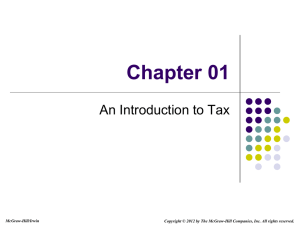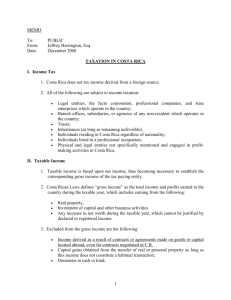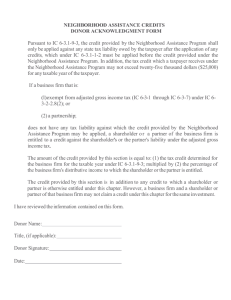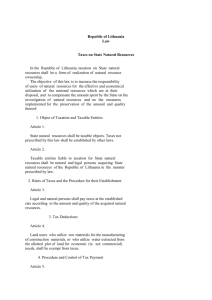i-ch3 - Haas School of Business
advertisement
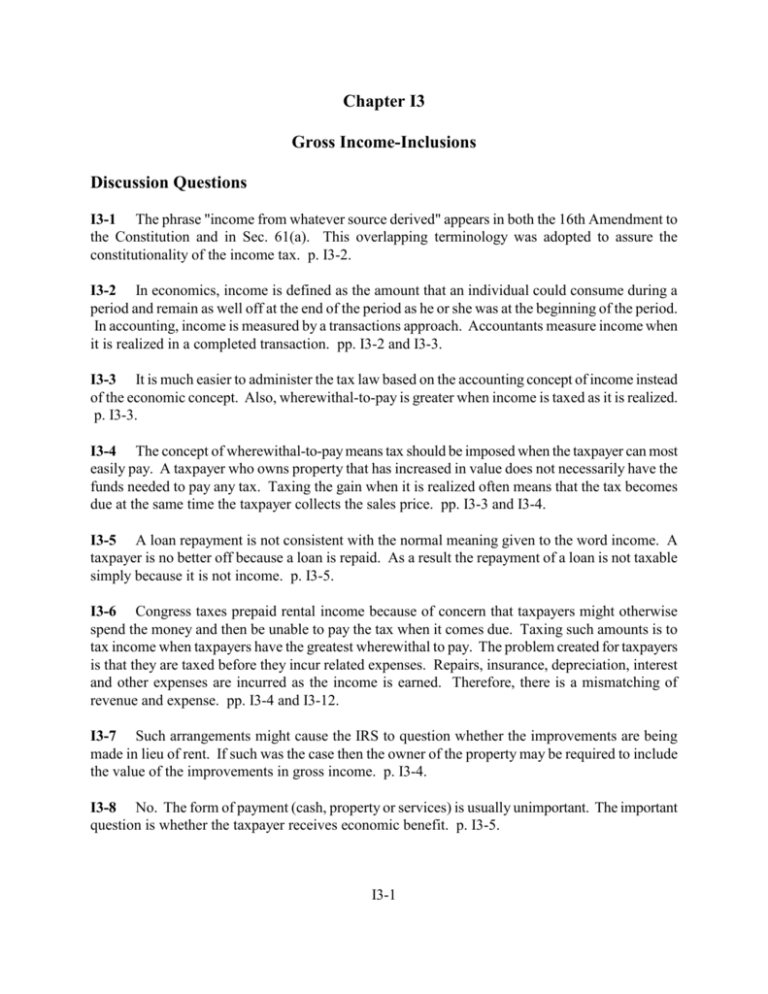
Chapter I3 Gross Income-Inclusions Discussion Questions I3-1 The phrase "income from whatever source derived" appears in both the 16th Amendment to the Constitution and in Sec. 61(a). This overlapping terminology was adopted to assure the constitutionality of the income tax. p. I3-2. I3-2 In economics, income is defined as the amount that an individual could consume during a period and remain as well off at the end of the period as he or she was at the beginning of the period. In accounting, income is measured by a transactions approach. Accountants measure income when it is realized in a completed transaction. pp. I3-2 and I3-3. I3-3 It is much easier to administer the tax law based on the accounting concept of income instead of the economic concept. Also, wherewithal-to-pay is greater when income is taxed as it is realized. p. I3-3. I3-4 The concept of wherewithal-to-pay means tax should be imposed when the taxpayer can most easily pay. A taxpayer who owns property that has increased in value does not necessarily have the funds needed to pay any tax. Taxing the gain when it is realized often means that the tax becomes due at the same time the taxpayer collects the sales price. pp. I3-3 and I3-4. I3-5 A loan repayment is not consistent with the normal meaning given to the word income. A taxpayer is no better off because a loan is repaid. As a result the repayment of a loan is not taxable simply because it is not income. p. I3-5. I3-6 Congress taxes prepaid rental income because of concern that taxpayers might otherwise spend the money and then be unable to pay the tax when it comes due. Taxing such amounts is to tax income when taxpayers have the greatest wherewithal to pay. The problem created for taxpayers is that they are taxed before they incur related expenses. Repairs, insurance, depreciation, interest and other expenses are incurred as the income is earned. Therefore, there is a mismatching of revenue and expense. pp. I3-4 and I3-12. I3-7 Such arrangements might cause the IRS to question whether the improvements are being made in lieu of rent. If such was the case then the owner of the property may be required to include the value of the improvements in gross income. p. I3-4. I3-8 No. The form of payment (cash, property or services) is usually unimportant. The important question is whether the taxpayer receives economic benefit. p. I3-5. I3-1 I3-9 In the 1930 case of Lucas v. Earl, the Supreme Court held that earnings from labor are taxed to the person who performed the services rather than the person who received the income. In the 1940 case of Helvering v. Horst, the Supreme Court held that income from property is taxed to the person who owns the property rather than the person who receives the income. One cannot assign income by arranging to have payment made to another person. p. I3-6. I3-10 Under community property law community income is divided equally between a husband and wife. The person who performed services that produce the income is ignored. In one sense this is contrary to Lucas v. Earl. In another sense the services of both the husband and wife contribute to income production. A spouse who works at home frees the other spouse to work outside the home. p. I3-7. I3-11 Jane is taxed even if her father is the employer. The same result would take place even if her wages were paid to one of her parents. If a child under age 14 has unearned income over $1,400, that income is, however, taxed at the parents' tax rates. Alternatively, the parents may elect to include the child's unearned income on their tax return. Since Jane has earned income the $3,000 of wages are not subject to the kiddie tax rules. p. I3-8. I3-12 Under the concept of constructive receipt, income is taxed to a taxpayer when it becomes available to the taxpayer. A taxpayer cannot defer the tax by refusing to accept payment. pp. I3-9 and I3-10. I3-13 Income is not constructively received if (1) the receipt is subject to substantial limitations or restrictions, (2) the payer does not have the funds necessary to make payment, or (3) the amount is unavailable to the taxpayer. pp. I3-9 and I3-10. I3-14 Income is considered to be earned by an accrual basis taxpayer when all the events have occurred which fix the right to receive the income and the amount of income can be determined with reasonable accuracy. p. I3-11. I3-15 a. Prepaid income is usually taxable when it is received. This is unlike financial accounting where income is reported when it accrues. b. The concept of wherewithal-to-pay and the desire by the Federal Government to raise tax revenues are the reasons that the tax law does not conform with financial accounting. c. One problem with this system is that taxpayers must often report income before expenses related to the income are incurred. The result is a mismatching of revenue and expenses. pp. I3-11 and I3-12. I3-16 The three conditions that must be met by an accrual basis taxpayer who wishes to defer reporting amounts received in connection with the sale of goods are (1) the goods are not on hand, (2) the amount received is less than the cost of the item, and (3) the income is deferred for financial accounting purposes. p. I3-12. I3-2 I3-17 An accrual basis taxpayer may defer reporting prepaid service income if the services are to be rendered before the end of the tax year following receipt. p. I3-12. I3-18 a. Interest on U.S. government obligations (issued after February 29, 1942) and foreign government obligations are taxable. A limited exclusion is available for Series EE savings bonds if the bond proceeds are used for educational purposes. Interest on obligations of states, territories, U.S. possessions and their political subdivisions is tax exempt. There are exceptions for federally insured, arbitrage, and private activity bonds. b. In general, tax exempt bonds pay a lower interest rate than taxable bonds because investors are willing to accept a lower return on tax exempt investments. c. No. In general, investors in lower tax brackets are better off investing in taxable bonds because their after tax return is higher. pp. I3-13 and I3-14. I3-19 Improvements made by a lessee that increase the leased property's value are included in the income of the lessor only if the improvements are made in lieu of paying rent or if rent is reduced because of the improvements. pp. I3-15 and I3-16. I3-20 Distributions are taxable to shareholders as dividends only to the extent they are made from either current or accumulated earnings and profits. Distributions in excess of earnings and profits are treated as a nontaxable recovery of capital. Distributions in excess of the basis of the stock are treated as capital gain. p. I3-16. I3-21 The Supreme Court concluded that stock dividends are not taxable because they are not income. No income is realized from stock dividends because there is no real change in the taxpayer's interest or the risks faced by the taxpayer. p. I3-17. I3-22 A constructive dividend is a dividend that is given some other label by the parties. For example, a dividend may be called compensation. Such amounts are reclassified as dividends for tax purposes. Thus, the deduction for compensation would be disallowed if a payment were reclassified as a dividend. pp. I3-17 an I3-18. I3-23 Alimony is considered to be taxable income to the recipient and a deductible expense for the payor. A property settlement is neither taxable income nor a deductible expense. p. I3-18. I3-24 a. Although Sec. 61 lists several different types of taxable income, it also says any item of income not listed is taxable unless it is specifically excluded. Therefore, a taxpayer must be able to identify a specific exclusion in order to avoid being taxed on an item of income. b. The Supreme Court has held that unrealized amounts are not income, and therefore are not taxable under the sixteenth amendment to the Constitution. c. Yes. It makes no difference whether the taxpayer receives cash or other form of payment. The important question is whether the taxpayer received economic benefit. Otherwise, taxpayers could easily avoid taxes by choosing to receive stock or other form of payment. I3-3 d. The basic question is whether the note has a market value. The receipt of a readily marketable note represents realization. p. I3-13. I3-25 a. A taxpayer who recovers an amount that was deducted in a previous year must report as gross income the amount recovered. The amount recovered need not be included in gross income if the taxpayer received no tax benefit. There is a tax benefit only if the deduction reduced the tax in the previous year. b. The reimbursement of a medical expense by insurance would be taxable only if the taxpayer had previously deducted the expense and it resulted in a tax savings. There would have been no tax benefit if either the taxpayer had claimed the standard deduction, or if the floor for the medical deduction exceeded the medical expenses. pp. I3-27 and I3-28. I3-26 The chapter outlines requirements found in Reg. Sec. 1.451-5 and Rev. Proc. 71-21 that, when met, allow taxpayers to defer the recognition of prepayments for goods and services. Further, taxpayers can control the terms of contracts to identify payments as deposits rather than prepaid income. This, of course, assumes that such payments are properly so classified. Moreover, taxpayers can prepay certain expenses in order to offset prepaid income. p. I3-30. I3-27 No. Such taxpayers do not receive relief under the tax benefit rule. Therefore, if a taxpayer is in a higher tax bracket when the recovery occurs, the taxpayer will pay more tax as a result of the recovery than was saved from the original deduction. pp. I3-27 and I3-28. I3-28 The main tax factor is whether the difference in interest rates is offset by the amount of tax that must be paid on the taxable interest income. Thus, George should look at the after-tax cash flow from each investment as the principal tax factor to consider. Other nontax factors, of course, influence the decision. These include the term of the two alternative investments, liquidity, marketability and other quality factors influencing risk. pp. I3-30 and I3-31. I3-29 The statement is incorrect. The forgiveness of debt does result in an economic benefit as the debtor is relieved of the obligation to make future payments. p. I3-23. I3-30 One point that they should realize is that if they accept the offer on the automobile that a portion of their social security benefits will be taxable because their provisional income would be greater than the base amount of $32,000 (married filing jointly). Also, there is some question as to the type of income to be reported form the sale of the automobile. Ordinarily, gains on the sale of investment and personal use assets are capital gains. The fact that the gain is attributable to the work they did themselves could cause the gain to be treated as ordinary. However, if this is the only automobile they have restored they probably are not considered to be in the automobile restoration business. Should they be in the automobile restoration business, they would also owe self-employment tax. The automobile probably is not covered by Sec. 1221 which classifies "artistic compositions" and similar property as ordinary assets. Reg. Sec. 1.1221-1(c) defines "similar property" to include I3-4 theatrical productions, radio programs, newspaper cartoon strips, and other property eligible for copyright protection. pp. I3-25 and I3-26. Issue Identification Questions I3-31 The primary issue is whether Andy has constructively received the delayed payment. Andy apparently earned the salary and was entitled to it. The company had the money to pay him on a timely basis. He agreed to delay payment for what may be a valid business reason. Nevertheless, he decided to delay payment, and that is likely to be construed as constructive payment. Although not discussed in the text until Chapter I6, there is an issue as to how much State can deduct for Andy's salary. As Andy is not a related party, Sec. 267 will not delay the deduction for his salary until it is included in his income. This assumes that the salary is reasonable. p. I3-9. I3-32 The salary levels raise questions relating to the assignment of income and constructive dividends. The reduction in Lisa's salary and the high level of Jane's salary suggest that there is an effort to remove income from Lisa's return (and estate) and transfer the amounts to Jane without a gift tax. Although students are not expected to be familiar with gift and estate taxes at this point, they should question why the salaries are at the level indicated in the question. In Lucas v. Earl, 8 AFTR 10287, 2 USTC ¶ 496 (USSC, 1930), a husband tried unsuccessfully to assign income from his law practice to his wife. The efforts by Lisa could be compared to the action in Lucas v. Earl. Also the issue of constructive dividends can be raised. The high salary paid to Jane may be viewed as a constructive dividend paid to her. p. I3-17. I3-33 The question in this case is when should Larry report the payments as income. The transactions do not always meet the precise requirements specified in Reg. Sec. 1.451-5 for advance payments as the payments sometimes exceed Larry's cost. However, the facts indicate that the amounts may qualify as deposits because customers receive refunds and make additional payments when orders are filled. Also, payments are sometimes refunded as Larry is unable to find items that meet customers needs. Rev. Rul. 72-519, 1972-2 C. B. 32 explains the difference between deposits and advance payments. In Rev. Rul. 72-519, however, the examples involve situations where the payments are not ordinarily credited toward the price of gasoline, utilities and other items illustrated. As a result, the treatment of payments in this case is not entirely clear. At this level, students should be able to recognize that the issue is when the payments are taxable and question the application of Reg. Sec. 1.451-5. pp. I3-8 and I3-9. Problems I3-34 a. Each employee would have to include $1,200 in gross income. Neither the form of the payment nor reason for the payment change the taxability. p. I3-4. b. Although there is an indirect economic benefit to the employees it would seem that no amount would have to be included in gross income. pp. I3-4 and I3-5. I3-5 c. The amounts would be taxable to the directors. The amount paid to the absent director would probably be taxable. The amount could, under some circumstances, be a constructive dividend. The constructive dividends would still be taxable. p. I3-17. I3-35 Amounts (a) and (b) have been constructively received. Amount (d) and (e) were unavailable to the taxpayer. Amount (c) was not constructively received because there were no funds available. pp. I3-9 through I3-11. I3-36 a. Since the proceeds were used to pay qualified college expenses for their dependent daughter and all the other requirements are met, all $500 of interest is excludable. b. The exclusion is limited to $300 ($500 interest x $1,200 net tuition and fees / $2,000 principal and interest). c. The excess modified AGI is $6,000 ($83,850 other income + $500 interest - $78,350 threshold). The reduction in the exclusion is $60 ($300 otherwise available exclusion x $6,000 excess AGI / $30,000). Therefore, the available exclusion is $240 ($300 - $60). pp. I3-14 and I3-15. I3-37 a. No. Recapture is necessary only if there is a reduction in alimony payments. As the transfer of the residence is not a cash payment, it does not qualify as alimony. b. The payment of $20,000 would be deductible by Fred and taxable to Tammy. c. No. Remarriage is an exception to the recapture provision. d. Her basis is $100,000. pp. I3-18 and I3-19. I3-38 a. A substantial portion, perhaps $165,000, would likely be classified as unreasonable and be reclassified as a dividend. b. The rent is identified as being about the same amount as that paid for similar buildings. It should not be a constructive dividend. c. Although payments to minor children are often examined closely, it would seem that most, if not all, of the salary would be deductible. d. No reason is given to indicate that the corporation is entitled to deduct the alimony payment. Since the compensation paid to Brad already exceeds the normal limitations, it is likely that this amount would be a constructive dividend to Brad. Brad should probably be entitled to a deduction for alimony paid. pp. I3-17 and I3-18. I3-39 In absence of any alternative explanation, (a), (b), (d), and (e) would likely be classified as constructive dividends. Probably (c) would not be since the sale is at the property's fair market value. pp. I3-17 and I3-18. I3-40 Stan would report the first and last month's rent, or $6,000, in 1997. In 1998 Stan would report $14,300 of gross income. This consists of February, March, April, and May rent collected in 1998 from Clay or $12,000; one-half month's rent withheld from the deposit or $1,500; and the amount withheld for damage or $800. Stan can deduct the cost of repairs. pp. I3-9 and I3-15. I3-41 In addition to the regular rental income from the apartment and health club Ed must include $2,600 in gross income. This consists of the lease cancellation payment of $1,000, the first month's I3-6 rent of $800, and the last month's rent of $800. The security deposit is not taxable. Since there is no reduction in rent, Ed need not include the value of the swimming pool in gross income. pp. I3-15 and I3-16. I3-42 All items are taxable. If she itemizes, Joy can deduct the $5 cost of the lottery ticket, and thus, be taxed on net lottery winning of $495 instead of $500 (i.e., $500 is included in gross income and $5 is deducted as an itemized deduction). p. I3-24. I3-43 Holly must report $1,300 of gross income determined as follows: Gain of City of Atlanta Bonds Interest on Series E Bonds Interest on City of Quebec Bonds Gross income $ 200 800 300 $1,300 pp. I3-13 through I3-15. I3-44 a. The exclusion ratio is 25.74 percent computed as follows: $40,000 25.9 x $500 x 12 = 25.74% The annual exclusion is then determined by multiplying the annual payments times the exclusion ratio. 0.2574 x 12 x $500 = $1,544.40 b. The amount of income that Tim reports will change if he outlives his life expectancy of 25.74 years. Thus, he will be taxed on the entire amount he collects after his total exclusion reaches $40,000. pp. I3-19 through I3-22. I3-45 Because this annuity is derived from Beth's employer's retirement plan, the simplified method is used. As Beth is age 65 the number of anticipated payments is 260. She can exclude $50.40 of each monthly payment ($13,104/260). Beth receives 6 monthly payments during the year, and the total exclusion is $302.40. p. I3-22. I3-46 a. Dan and Diana will be taxed on $750 of the social security benefits. Adjusted gross income (excluding social security) Plus: 50% of social security Provisional income $31,000 2,500 $33,500 The taxable portion is the lesser of $2,500 (0.50 x $5,000 of social security benefits) or $750 [0.50 x ($33,500 of provisional income - $32,000)]. I3-7 b. Dan and Diana will be taxed on $4,250 of the social security benefits. I3-8 Adjusted gross income (excluding social security) Plus: 50% of social security Provisional income $46,000 2,500 $48,500 The taxable portion is the lesser of $4,250 (0.85 x $5,000 of social security benefits) or $6,325 [the lesser of $6,000 or .50 x $5,000 of social security benefits + 0.85 x ($48,500 of provisional income $44,000)]. pp. I3-25 and I3-26. I3-47 a. Assuming she sells all of the stock this year and that she collects the dividends before the sale, one half of the social security benefits are taxable. Pension Social Security (50%) Dividends Gain on the sale of stock Provisional income $10,000 3,500 1,000 20,000 $34,500 The taxable portion is the lesser of $5,950 (0.85 x $7,000 of social security benefits) or $3,925 [the lesser of $4,500 or 0.50 x $7,000 of social security benefits + 0.85 x ($34,500 of provisional income - $34,000)]. Thus, her AGI of $34,925 is computed as follows: Pension Social security benefits Dividends Gain AGI $10,000 3,925 1,000 20,000 $34,925 b. On the other hand, if she only sells half of the stock this year, none of the social security benefits are taxable. That is because the provisional (income computed) below is less than the $25,000 threshold for single social security recipients. Pension Social security benefits (50%) Dividends Gain Provisional income $10,000 3,500 1,000 10,000 $24,500 The result is that her AGI (computed below) is $13,925 lower than in part (a) because the capital gain is only $10,000 and none of the social security benefits are taxable. Of course, the other half of the gain will be taxable next year. She, however, has avoided paying tax on any of her social security benefits by selling half of the stock this year and half next year. I3-9 Pension Dividends Gain AGI $10,000 1,000 10,000 $21,000 pp. I3-25 and I3-26. I3-48 Provisional income is $46,500 computed as follows: AGI ($42,000 salary + $1,000 interest) Plus: 50% of social security (0.50 x $7,000) Provisional income $43,000 3,500 $46,500 The taxable portion of the social security benefits is equal to $5,625 which is the lesser of: (1) $5,950 (0.85 x $7,000 social security benefits), or (2) $5,625 [lesser of (a) $6,000 or (b) 0.50 x $7,000 of benefits plus 85% x ($46,500 provisional income - $44,000)]. pp. I3-25 and I3-26. I3-49 Salary Dividends Pension Rent Social Security Adjusted gross income $25,000 2,700 2,400 ( 5,000) 1,200 $26,300 The taxable portion of the pension is $2,400 (4 x $1,000 x 0.60). The rental activity results in a net loss of $5,000 which is subtracted in computing adjusted gross income. One-half of the social security benefits of $1,200 (0.50 x $600 x 4) is taxable. The formula amount is $2,150 (see below) but since that is over one-half of the benefit, the formula is not applicable. Adjusted gross income (excluding social security benefits) Plus: 50% of social security benefits Tax exempt interest Provisional income Minus: Base amount Total Formula amount $25,100 1,200 3,000 $29,300 (25,000) $ 4,300 x 0.50 $ 2,150 pp. I3-16, I3-19 through I3-22, I3-25 and I3-26. I3-50 a. Since Fred did not itemize in 1998, he is not required to include the refund in income. I3-10 b. The fact that Fred does not itemize in 1999 is irrelevant. Whether he must include the refund in gross income depends on whether he received tax benefit in 1998. c. Under the accrual method, Fred would deduct the tax liability rather than the amount withheld. Therefore, he is not required to report the refund as income. d. If he suffered a loss during 1998 he would not have benefitted from the itemized deduction. Therefore, he will not have to report the refund as income. e. The fact that Fred has a loss during 1999 has no bearing on whether he must include the refund in gross income. Of course, he will owe no tax even if he does include the refund in income. f. Fred will have benefitted from only $400 of the deduction. Therefore, only $400 must be included in gross income. pp. I3-27 and I3-28. I3-51 a. Although she must subtract the AGI floor of $2,250, Jan can deduct the remainder of the medical expense payments of $6,750 ($9,000 - $2,250) if she pays the balance of $9,000 in 1998. b. If she pays and deducts the expenses in 1998, she must include a portion of the reimbursement in her 1999 gross income under the tax benefit rule. She received tax benefit of $6,750 from the medical expense deduction in 1998. Thus, Jan is required to include $6,750 in gross income as a result of the reimbursement in 1999. pp. I3-27 and I3-28. I3-52 a. None. The amount received is a recovery of capital. b. $120,000. Both the reimbursement for lost profits of $40,000 and the punitive damages of $80,000 are taxable. c. A loan repayment is not taxable. The fact that Dick had to sue is not relevant. d. Accounting fees are taxable. The fact that Fran had to sue is not relevant. As a cash basis taxpayer, Fran would report the fee when collected. As an accrual basis taxpayer, Fran would report the fee when the services were rendered. Fran would not report the fee a second time when collected unless it had been written off as a bad debt. pp. I3-26 and I3-27. I3-53 a. Yes. The payment is taxable as there are no restrictions on Jesse's use of the money. As Jesse is in the 28% tax bracket his additional tax from including the $8,000 in gross income is $2,240 (.28 x $8,000). b. Jesse can simply deduct the $8,000 which will reduce his tax by $1,200 (.15 x $8,000). Alternatively, he can compute the tax that he would otherwise pay and then reduce that tax by the additional $2,240 tax he paid the previous year when he reported the lump-sum severance payment. Obviously, the second alternative is preferred. c. As the amount is less than $3,000, Jesse has only the option of deducting the repayment. pp. I3-28 and I3-29. I3-54 a. They would save $144 (0.36 x $400) per year. The daughter would not be subject to tax on any of the interest. ($400 interest - $700 standard deduction). b. They would save $144 of taxes per year, but would lose $100 [$400 - (0.06 x $5,000)] of interest. Thus, they would be better off to acquire the tax-exempt bonds. I3-11 c. They would save $360 (0.36 x $1,000). This assumes no phase-out of itemized deductions. d. If the salary is reasonable, the full $10,000 should be deductible as a business expense. Otherwise, the amount deemed unreasonable would be treated as a gift. If other gifts were made during the year it could result in a gift tax. pp. I3-29 through I3-31. I3-55 a. Even though an 11 year old is subject to the kiddie tax, there will be no tax liability as long as the son's income is less than $700 per year. b. The son should file a return and elect to report interest annually. If interest is reported annually there will be little if any tax. If all interest is reported when the bonds mature there will be a large income reported in a single year and a significant tax liability. c. Each gift potentially increases the child's income. If a dependent child's unearned income increases above $700, there is a potential tax and the tax on income over $1,300 will be at the parent's rate as long as the child is under age 14. Therefore, it may be desirable to either elect out of the annual reporting of Series EE interest or choose to make gifts of other types of assets. Growth stocks might be desirable as they produce little current income. pp. I3-30 and I3-31. Comprehensive Problem I3-56 a. No. She would be protected by the innocent spouse provision of Sec. 66. b. Head-of-household (see Chapter I2). c. $1,500. One half of her husband's earnings prior to the time he left home. d. No. The amount of income is less than her personal exemption (see Chapter I2). pp. I3-17 through I3-19. I3-57 Salary Interest on money market account Interest on loan to brother Fee for jury duty State income tax refund Dividend on Ace stock Dividend on Tray stock Adjusted gross income Minus: Exemptions ($2,700 x 2) Itemized deductions Taxable income $57,000 200 2,100 50 140 1,000 1,400 $61,890 ( 5,400) ( 9,000) $47,490 Gross tax Minus: Withholding Net Tax Refund Due $10,002 (11,000) $ 998 I3-12 Tax Form/Return Preparation Problem I3-58 (See Instructor's Guide) Case Study Problems I3-59 (See Instructor's Guide) I3-60 (See Instructor's Guide) I3-61 (See Instructor's Guide) Tax Research Problem I3-62 (See Instructor's Guide) I3-13


